Scottish maternal and infant nutrition survey 2017
Results from the 2017 Scottish Maternal and Infant Nutrition Survey. This first Scotland-only survey gathered data on maternal nutrition and infant feeding.
3. Birth and Subsequent Hospital Care
Events during and after birth may affect the way that babies are fed shortly after being born. For this reason, women in the 8-12 week survey were asked about their experience of giving birth and about any extra care that their baby received shortly after being born.
This section of the report presents survey findings about giving birth. Later sections examine some of these findings in relation to respondent's infant feeding choices.
This section of the report also presents information from the 8-12 month survey about infant health issues and any overnight hospital stays that were required apart from when a baby was born.
3.1 Giving birth
The majority of respondents to the 8-12 week survey (98%) gave birth in a Scottish hospital / Community Maternity Unit ( CMU), with a very small number giving birth in the ambulance on the way to hospital. Two percent (2%) gave birth at home.
[Table 3.1]
Ninety-three percent (93%) of respondents indicated that their pregnancy was full term (37 weeks pregnant or more) when their baby was born. Five percent (5%) gave birth prematurely (before 37 weeks), with a small number of babies being born before 32 weeks (0.5%).
[Table 3.2]
These findings are similar to statistics collected on a routine basis that show that the vast majority of the 54,488 live births registered Scotland in 2016 took place in a hospital or in a Community Maternity Unit. ( R12)
Official national statistics for births in Scottish hospitals (year ending 31 st March 2017) show similar proportions of premature and full term births amongst women giving birth in Scotland. ( R8) However, the proportion of mothers giving birth at 42 weeks or later was higher in this survey (9% versus 2% in official statistics). This difference may partially be explained by the fact that survey respondents were asked to state how many weeks pregnant they were to the nearest whole week only. Furthermore, this survey includes mothers who gave birth at home.
Method of delivery
Some methods of delivery or types of medication / pain relief used during labour may affect a baby's initial ability to breastfeed well. For example, if a mother has a caesarean section it may take a little longer to get breastfeeding going. This may also be the case if medication used during labour makes the baby sleepy after birth. ( R20)
The majority of respondents reported that they had a normal vaginal delivery (57%). Eleven percent (11%) had a vaginal delivery with use of forceps, and 3% using a vacuum cap on the baby's head. Less than 0.2% reported a vaginal breech birth. Twenty-nine percent (29%) of respondents had a caesarean section.
[Figure 3.1; Table 3.3]
Around three in ten respondent had a caesarean section.
Figure 3.1: Thinking about the birth of your baby, what kind of delivery did you have? (Percentage of respondents who indicated each method of delivery).
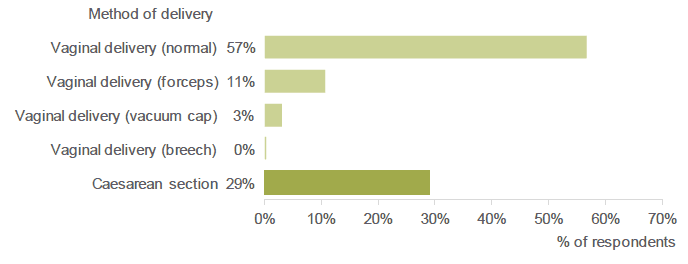
Source: Q6 , 8-12 Week Survey
Older mothers were more likely to have given birth by caesarean section than younger mothers. Forty percent (40%) of respondents aged 35 or over had a caesarean compared to 20% of those aged 20-24. There was no significant variation amongst deprivation categories.
[Table B1: 8-12 Week – Results by Age of Respondent & B2: 8-12 Week – Results by SIMD]
Official national statistics for births in Scottish hospitals (year ending 31 st March 2017) show a very similar pattern of methods of delivery amongst women giving birth in Scotland. ( R8) These statistics also show that the proportion of women delivering by caesarean section has increased steadily in Scotland since 1975.
The methods of delivery are also similar to that reported for Scottish respondents in the 2010 UK-wide Infant Feeing Survey; however caesarean sections were reported slightly less often in the earlier survey (normal 60%; forceps 12%; vacuum 3%; caesarean 26%). ( R7)
Types of pain relief
Respondents were asked about the types of pain relief they had used during labour or birth. The majority (70%) reported using gas and air. Forty percent (40%) of respondents had received an epidural or spinal injection, while 29% had received an injection of morphine or a similar type of pain killer.
Thirty-nine percent (39%) of respondents said that they had used natural methods of pain relief such as breathing and massage, with 13% using water or a birthing pool and 12% using a TENS (transcutaneous electrical nerve stimulation) machine.
[Figure 3.2; Table 3.4]
Nearly all respondents used some form of pain relief during labour or birth.
Figure 3.2: During your labour or birth, did you use any of the following methods to relieve the pain? (Percentage of respondents who reported using each type of pain relief).
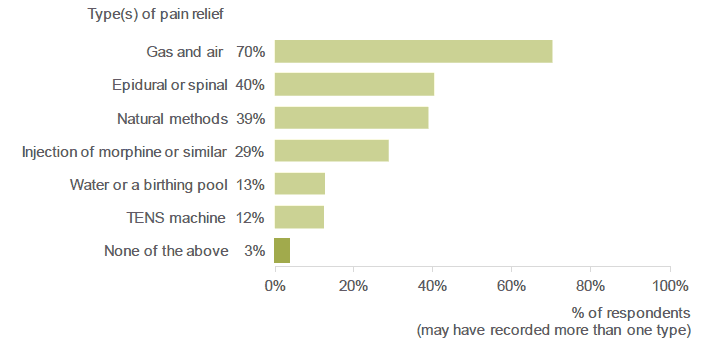
Source: Q7 , 8-12 Week Survey
Birth weight
An infant's weight at birth can be impacted both by the gestation period and how well the baby has grown in the uterus. Generally speaking, infants weighing 2.5 kg or more, but less than 4 kg, at birth are considered to have a "normal" birth weight. A birth weight of less than 2.5 kg is considered to be low, whereas 4 kg or more is considered high. ( R8)
As highlighted above, the vast majority of respondents (93%) indicated that their pregnancy was full term when they gave birth, with 5% giving birth prematurely.
- The majority of babies who were born at full term had a normal birth weight (83%). A small proportion (2%) had a low birth weight, while 15% were classified as heavier babies.
- Where babies were born prematurely, more than half (57%) had a very low or low birth weight; 42% were a normal weight at birth and 1% were classified as heavy.
[Figure 3.3; Table 3.5]
More than half of babies who were born prematurely had a low or very low birth weight.
Figure 3.3: How much did your baby weigh when he/she was born? (Percentage of respondents who had a baby in each birth weight category, by gestation period).
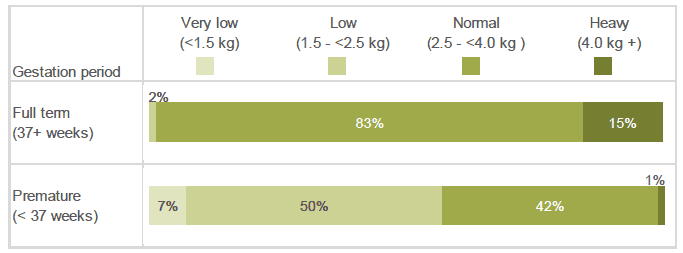
Source: Q3, Q8, 8-12 Week Survey
Overall, the birth weight profile of infants in this survey is very similar to that reported in the official national statistics for births in Scottish hospitals (year ending 31 st March 2017). ( R8)
Length of stay in hospital / Community Maternity Unit
Most respondents stayed in hospital for two days or less following the birth of their baby (72%). Respondents who gave birth prematurely reported lengthier stays than those who were full term, but it is unclear whether respondents sometimes recorded the length of time that their baby stayed in hospital rather than themselves.
[Figure 3.4; Table 3.6]
Most respondents stayed in hospital for two days or less following the birth of their baby.
Figure 3.4 How long after your baby was born did you stay in hospital or a Community Maternity Unit? (Percentage of respondents who stayed for each length of time).
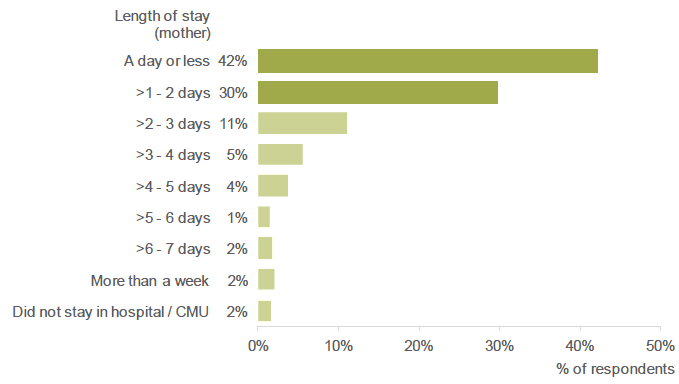
Source: Q5 , 8-12 Week Survey
3.2 Experiences shortly after birth
Skin to skin contact
Skin-to-skin contact soon after birth is known to help mothers establish a first successful breastfeed. ( R20, R21) The majority of respondents (86%) reported that they had been able to have skin-to-skin contact with their baby within an hour of the birth, however this varied by method of delivery:
- 93% of respondents who had a normal vaginal birth reported that they had skin-to-skin contact with their baby within an hour.
- 73% of respondents who had a caesarean indicated that they had skin-to-skin contact with their baby within an hour.
[Table 3.7]
In the 2010 UK-wide Infant Feeding Survey, 81% of respondents across the UK reported skin-to-skin contact with their baby within an hour of the birth (normal vaginal birth 88%; caesarean 61%). ( R7 )
Feeding in the hours after birth
Eight-two percent (82%) of all respondents reported that their baby had fed (breast milk or formula) within in the first two hours following the birth.
[Table 3.8]
Health problems that affected the mother's ability to feed
The health of both mother and baby after birth can affect initial feeding choices, possibly delaying skin-to-skin contact and/or the initiation of breastfeeding or expressing breast milk. ( R20)
One in ten respondents (10%) reported that they had experienced health problems immediately or shortly after the birth that affected their ability to feed their baby the way they had wanted to:
- 6% reported that they had birth complications
- 3% specified other health complications
- 2% said that they "just didn't feel well".
[Table 3.9a & 3.9b]
3.3 Extra care
Infants who are unwell after birth sometimes require extra care. This care may be given within a neonatal unit or a special care baby unit depending on the infant's level of need. Some babies who require additional care receive this care in a children's hospital or in a transitional care ward whilst remaining with their mother. ( R8)
Overall, 13% of respondents reported that their baby had spent time being cared for in neonatal care, special care, transitional care or a children's hospital within the first week of his/her birth. However, amongst respondent who had given birth prematurely, this rose to 65% (10% for full term pregnancies).
Forty-one percent (41%) of respondents who gave birth prematurely indicated that their baby had spent time in neonatal care, and 28% in a special care baby unit. Only a small proportion of infants spent time in a transitional care unit or a children's hospital.
[Figure 3.5; Table 3.10]
Two-thirds of respondents who gave birth prematurely reported that their baby had spent time in some type of extra care.
Figure 3.5: Within the first week of his/her birth, was your baby cared for in a Special Care Baby Unit, a Neonatal Unit, a Transitional Care Unit or admitted to a Children's Hospital? (Percentage of respondents who indicated that their baby spent time in each type of care, by gestation period).

Source: Q13, Q3, 8-12 Week Survey
Official national statistics for births in Scottish hospitals (year ending 31 st March 2017) show that 11% of babies spent time in some type of special care. However, complete data were not available for some NHS boards at the time of this report's publication. ( R8)
Time spent in extra care
Amongst respondents whose babies had spent time in extra care, infants who were born prematurely spent a longer period of time in extra care than those who were full term.
Overall, half of respondents (52%) whose babies had spent time in extra care were there for no more than three days, with 29% staying for one day or less. However, amongst respondents who had given birth prematurely, 62% of infants had spent more than a week in extra care, with 15% spending more than a month.
[Figure 3.6; Table 3.11]
Preterm infants spent more time in extra care.
Figure 3.6: How long did your baby stay in the Special Care Unit, Neonatal Unit, Transitional Care Ward or Children's Hospital? (Percentage of respondents who selected each length of time, by gestation period. Respondents whose baby spent time in extra care).

Source: Q14, Q3, 8-12 Week Survey
Thirty-eight percent (38%) of respondents whose baby had spent time in extra care felt that this had affected their ability to feed their infant the way they had wanted to. However, more than half (57%) felt that it had not affected their ability to feed their baby; 3% were unsure.
[Table 3.12]
Methods of expressing breast milk
Amongst respondents whose babies had spent time in extra care, nearly two-thirds (64%) had received information about methods of expressing breast milk while their baby was still in this type of care. One in ten (10%) turned down the offer of information because they felt they did not need it. Twenty-five percent (25%) of respondents had not been offered any information; 10% indicated that the information had not been offered, but they had told staff they intended to formula feed, the remaining 15% indicated that the information had not been offered.
[Figure 3.7; Table 3.13]
Nearly two-thirds of respondents with a baby in extra care had received information about expressing breast milk, but a quarter had not been offered this information.
Figure 3.7: While your baby was in the Special Care Unit, Neonatal Unit, Transitional Care Ward or Children's Hospital, did you receive any information about methods of expressing breast milk? (Percentage of respondents who selected each response. Respondents whose baby spent time in extra care).

Source: Q16, 8-12 Week Survey
Amongst respondents whose babies had spent time in extra care, a quarter (26%) had been offered an electric breast pump to take home. Forty-eight percent (48%) indicated that they did not need a breast pump, however 23% said they were not offered one, but would have liked to have been.
[Figure 3.8; Table 3.14]
Only a quarter of respondents whose baby had spent time in extra care were offered an electric breast pump to take home; another quarter would like to have been offered one.
Figure 3.8: Were you offered an electric breast pump to take home? (Percentage of respondents who selected each response. Respondents whose baby spent time in extra care).
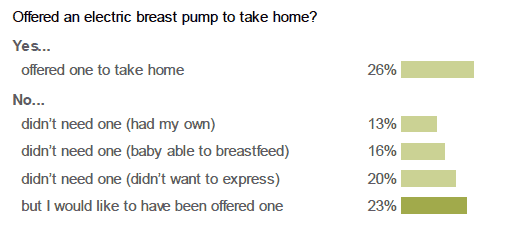
Source: Q17, 8-12 Week Survey
3.4 Babies health and subsequent hospital care
Respondents to the 8-12 month survey were asked whether their baby had ever experienced certain health issues and whether their infant had spent a night in hospital apart from when born.
Health issues
The most common health issues experienced by babies in the 8-12 month survey were constipation (35%), sickness or vomiting (33%), colic / painful wind (32%) and reflux (30%). Only 15% of respondents said that their baby had not experienced any of the issues listed in the survey.
[Figure 3.9; Table 3.15]
Around a third respondents indicated that their infant had experienced constipation, sickness or vomiting, colic / painful wind or reflux.
Figure 3.9: Has your baby ever experienced any of the following health issues? (Percentage of respondents who indicated that their baby had experienced each type of health issue).
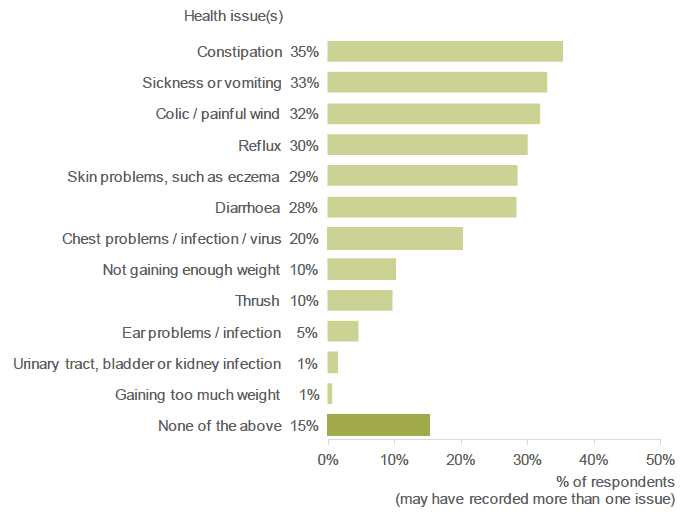
Source: Q23 , 8-12 Month Survey
In the 2010 UK-wide Infant Feeding Survey, constipation, colic / painful wind, sickness or vomiting and diarrhoea were the most common health issues reported by respondents. However, reflux and eczema / skin problems were not specifically listed as response options in the 2010 survey. ( R7)
Overnight hospital stays
The majority of respondents (87%) said that their baby had not stayed in hospital overnight apart from when they were born.
Amongst the 13% of respondents who reported that their baby had stayed in hospital overnight, a chest problem was the most commonly reported reason (5%). Lack of weight gain or losing a large amount of weight was reported as a reason by 2% of respondents.
Other reasons, not specifically listed in the survey, but mentioned by respondents were other medical reasons (1%), other infections (1%), newborn issues (1%) and because the mother had to stay in hospital (1%).
[Figure 3.10; Table 3.16a & 3.16b]
Chest problems, including infections and viruses, were the main reason that babies had stayed in hospital overnight.
Figure 3.10: Why has your baby stayed in hospital overnight? (Percentage of respondents who selected each reason).
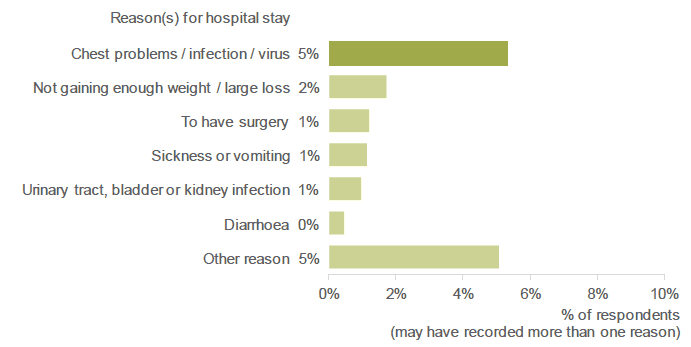
Source: Q25 , 8-12 Month Survey
In the 2010 UK-wide Infant Feeding Survey, chest problems were also the most commonly reported reason for overnight hospital stays. ( R7)
Contact
There is a problem
Thanks for your feedback